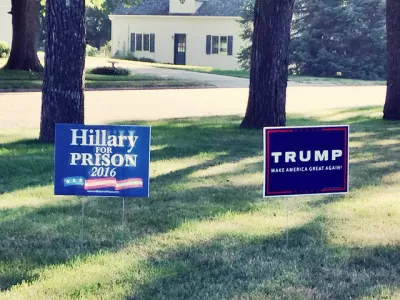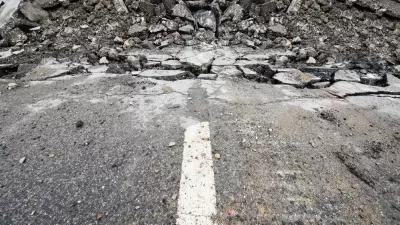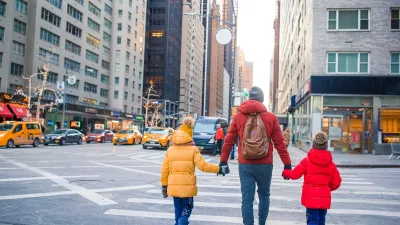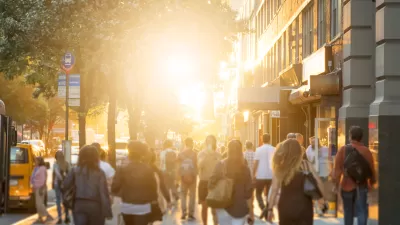In 2016, Republicans did worse than usual in affluent sprawl suburbs, while gaining a little ground in working-class cities.

Commentators often interpret elections as a battle between Democratic cities and Republican suburbs. For example, one Planetizen comment stated: "Trump was elected because the forgotten rural and suburban Americans (yes, coincidentally mostly white) responded negatively to an urban progressive agenda espousing Democratic Party/candidate" (emphasis mine). But in fact, the urban/suburban gap may have narrowed this year in many regions.
Urban voting data is often hard to find, because most cities are parts of larger counties. But in a few regions, cities were their own counties- and here the results were actually quite mixed.
In gentrified cities like San Francisco, Trump did even worse than the typical Republican. Trump only got 9 percent of the votes in San Francisco (down from Mitt Romney's already-dismal 13 percent). Similarly, he lost GOP voters in Manhattan (10 percent, down from Romney's 15 percent) and the District of Columbia (4 percent, down from Romney's 7 percent). In Denver, the Republican vote nosedived from 24 percent in 2012 to 19 percent this year.
On the other hand, in some urban places Trump did no worse than Romney, or even a tiny bit better. In New York's outer boroughs, he held steady or gained a bit of ground. He thumped Hillary Clinton in semi-suburban Staten Island (which Obama carried) by a 56-40 margin. He gained a point in two in Brooklyn (about 18 percent, up from Romney's 17) and Queens (22 percent, up from Romney's 20). Similarly, he gained a few votes in Philadelphia (15 percent, up from Romney's 14) and held steady in St. Louis (at about 16 percent).
But Trump lost ground in sprawl—or more precisely, the kind of affluent, car-dominated suburb that is the traditional American stereotype of sprawl. Chester County, Pa. presents an extreme example. it begins almost 20 miles from downtown Philadelphia, and ends almost 60 miles from downtown at the Maryland border. This well-off county has traditionally been GOP territory, voted for George W. Bush 53-43 in 2000, and voted for Mitt Romney in 2008. But in 2016 Chester thumped Trump by a 51-42 margin. Affluent, closer-in Montgomery County has been trending Democratic for decades; but while it gave Mitt Romney 42 percent of its votes, Trump lost it by a 58-37 margin. However, Trump's suburban losses in Pennsylvania were outweighed by a tide of rural votes.
Similarly, the Washington suburbs turned on Trump. Loudoun County, Virginia, a land of high-tech, big-money sprawl, voted 56-40 for George Bush in 2000. By 2012, it was ready to support Obama by a narrow 51-47 margin. In 2016, it clobbered Trump 55-39. Similarly, Fairfax County's GOP vote share nosedived from 39 percent to an almost urban 28 percent. As a result, the Democratic ticket did almost as well in Virginia as in 2012.
Even in the Republican South, some suburbs were immune to Trump's charm. Cobb, Gwinnett, and Henry Counties all extend far outside Atlanta, all gave Ronald Reagan over 2/3 of their votes in 1984, and all voted for Mitt Romney, by margins ranging from 51-47 (Henry) to 55-42 (Cobb). But all three switched to the Clinton-Kaine ticket. Only the outermost Atlanta exurbs, such as Cherokee County (which begins over 30 miles out) were solidly pro-Trump. Trump even gained votes in the already-Republican suburbs at the fringes of the metro area, such as Haralson and Heard County (which begin around 50 miles out).
Even in Texas, Trump lost a few suburbs: Fort Bend County outside Houston voted almost 60-40 for George Bush and 53-46 to Romney, but swung to Clinton this year. Outside Dallas, Romney won Denton and Collin Counties with about 65 percent each—about 8 percentage points ahead of Trump's showing in both counties. By contrast, Trump improved on Romney's performance in Delta County 75 miles from downtown Dallas; he got 80 percent of the vote there, as opposed to Romney's 75 percent.
In the Midwest, Trump did a little better. Trump won the WOW (Washington, Ozaukee, Waukesha) counties outside Milwaukee—but even here, he lost some Romney voters. His vote totals in the three counties ranged from 55-67 percent, while Romney topped 64 percent even in Ozaukee (the least Republican of the three). Here too, Trump's weakness in suburbia was balanced out by a tide of rural votes.
However, Trump did gain support in some more working-class suburbs, especially in the Midwest and in smaller metro areas. Macomb County (outside Detroit) switched from Obama to Romney while the Democrats held onto richer Oakland County. And in Geauga and Medina Counties outside Cleveland, Trump did better than Romney. And in western Pennsylvania, Trump improved on Romney's performance in most suburban counties. But on balance, the Republican ticket lost votes in much of America's suburban sprawl while gaining votes in rural and small-town America, and (to a lesser extent) in the almost- and newly-suburban counties at the fringes of metropolitan America.

Alabama: Trump Terminates Settlements for Black Communities Harmed By Raw Sewage
Trump deemed the landmark civil rights agreement “illegal DEI and environmental justice policy.”

Planetizen Federal Action Tracker
A weekly monitor of how Trump’s orders and actions are impacting planners and planning in America.

Why Should We Subsidize Public Transportation?
Many public transit agencies face financial stress due to rising costs, declining fare revenue, and declining subsidies. Transit advocates must provide a strong business case for increasing public transit funding.

Understanding Road Diets
An explainer from Momentum highlights the advantages of reducing vehicle lanes in favor of more bike, transit, and pedestrian infrastructure.

New California Law Regulates Warehouse Pollution
A new law tightens building and emissions regulations for large distribution warehouses to mitigate air pollution and traffic in surrounding communities.

Phoenix Announces Opening Date for Light Rail Extension
The South Central extension will connect South Phoenix to downtown and other major hubs starting on June 7.
Urban Design for Planners 1: Software Tools
This six-course series explores essential urban design concepts using open source software and equips planners with the tools they need to participate fully in the urban design process.
Planning for Universal Design
Learn the tools for implementing Universal Design in planning regulations.
Caltrans
Smith Gee Studio
Institute for Housing and Urban Development Studies (IHS)
City of Grandview
Harvard GSD Executive Education
Toledo-Lucas County Plan Commissions
Salt Lake City
NYU Wagner Graduate School of Public Service






























